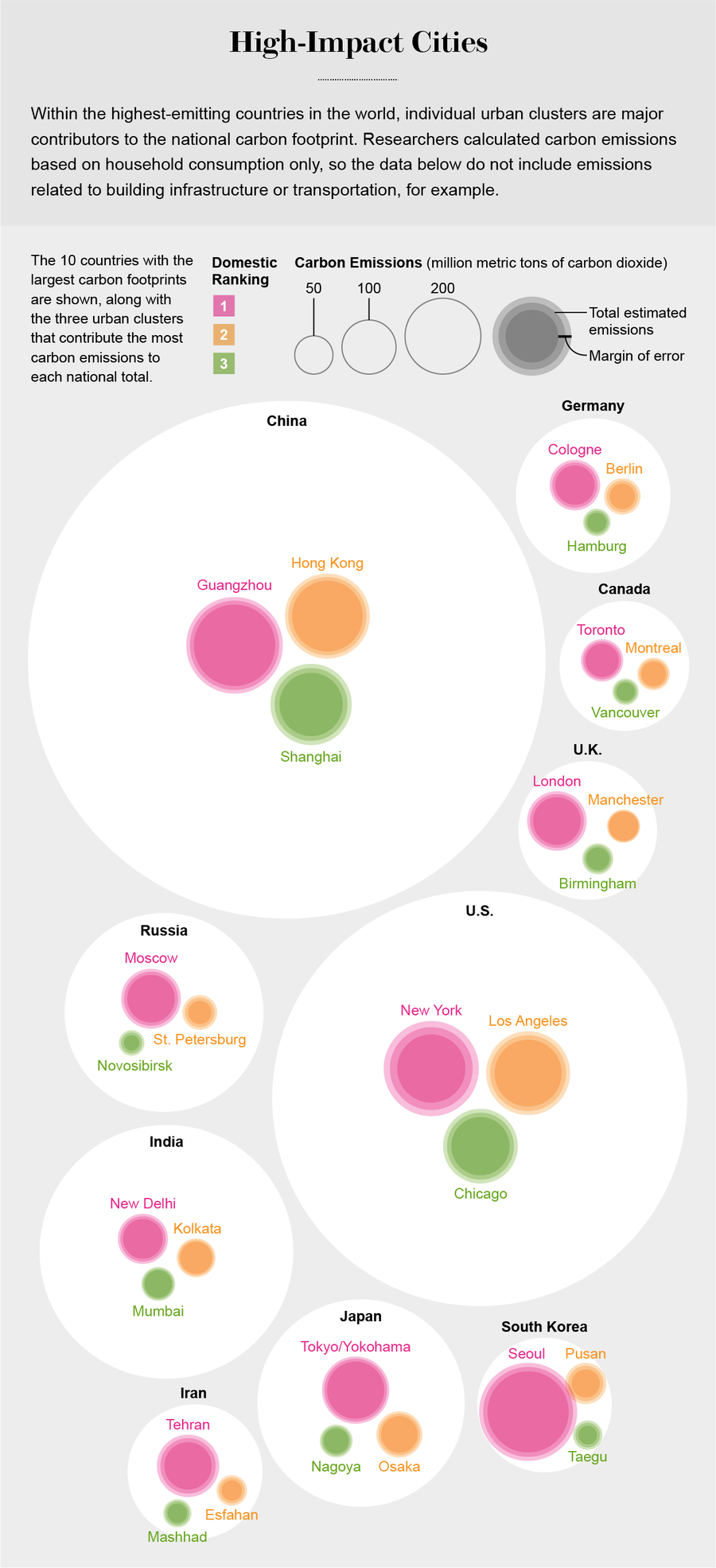Residents of just 100 cities account for 20 percent of humanity’s overall carbon footprint, according to a new estimate of carbon dioxide emissions.
This share is comparable to worldwide industry-related emissions, showcasing how individual consumption is a major contributor of excess carbon dioxide. The analysis calculated emissions in 13,000 cities, making it the most wide-scale look at cities’ carbon footprints to date. The results, the international research team says, illuminate the degree to which residents of just a few cities can contribute to a country’s overall footprint.
Before this study teams of researchers had only calculated the complete carbon footprints of about 150 cities. The new study’s broad scope offers climate scientists and public officials valuable insight into metropolises for which local emissions data is sparse or nonexistent, such as Tehran, says Anu Ramaswami, an environmental engineer at the University of Minnesota who was not involved in the new research.
On supporting science journalism
If you're enjoying this article, consider supporting our award-winning journalism by subscribing. By purchasing a subscription you are helping to ensure the future of impactful stories about the discoveries and ideas shaping our world today.
Previous calculations have mostly tallied up factors like the emissions associated with energy production, business, industry and transportation to generate a city’s overall footprint. But “it’s simply too labor-intensive to do these individual footprints for each city” by adding all these sectors together, says Dan Moran, the new study’s lead author and a researcher at the Norwegian University of Science and Technology. “We needed to take this more macrolevel” in order to calculate more cities’ emissions. So Moran and his research team started with a broader view, relying on previously calculated carbon output across wider scales—from individual U.S. zip codes to provinces and states in Europe, Japan and China to national emissions estimates, and then estimating what proportion of those figures was accounted for by each city.

Credit: Amanda Montañez. Source: "Carbon Footprints of 13,000 Cities," by Daniel Moran et al., in Environmental Research Letters; May 23, 2018
The team disaggregated that by gathering information on local income, which they used as a proxy for emissions: the more wealth, the greater ability and likelihood of engaging in behaviors that emit more carbon dioxide, according to the most up-to-date scientific literature. The team used this data, along with population estimates, to figure out how much of the national- and state-level emissions to attribute to each city.
This method only estimates the household consumption slice of the carbon footprint, including the emissions involved in cultivating and delivering the food people consume as well as the types of transportation used in a city. But the approach does not include emissions related more directly to industry and land use. The United Nations Intergovernmental Panel on Climate Change has found industry accounts for nearly a quarter of overall greenhouse gas emissions; agriculture and land use combined make up another quarter. Despite leaving out those CO2 contributors, Moran says the team’s findings demonstrate the critical impact city dwellers have on overall carbon emissions.
The bulk of a country’s consumption-related carbon emissions can be concentrated in just a few cities: For example, residents of South Korea’s capital, Seoul, account for about 45 percent of that nation’s overall carbon emissions; in the U.K., London, Manchester and Birmingham combined contribute more than 20 percent of national output; whereas in the U.S. people living in Chicago, New York and Los Angeles combine to account for nearly 10 percent of the country’s overall footprint.
It may seem obvious more people and wealth mean more carbon emissions. But Moran was surprised by just how much of that output is concentrated in metropolitan areas. He was especially taken aback when, during his research, he found roughly one third of an urban resident’s footprint is determined by that city’s public transportation options and building infrastructure. Ultimately, he sees the work, published in May in Environmental Research Letters,as a call for cities to take action on reducing their emissions. If cities would switch to a more efficient energy source or make their public buses electric, Moran says, they could slash their emissions by at least 25 percent. “There is a lot of power in cities,” he says, “and I think at the more local level of government you can take faster action than at the national level.”
